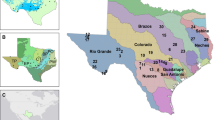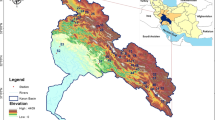Abstract
The distribution of macroinvertebrates was investigated among sites within five geothermally influenced and two non- or minimally-influenced streams in the Taupo Volcanic Zone, New Zealand, to examine the responses of communities to broad environmental gradients within and among habitats. To date, examination of geothermal stream macroinvertebrates has typically been from single habitats, and has not been examined over a regional scale. Sites within and among streams represented a range of sizes, depths, water velocities and substrate types. Sites with little or no geothermal influence typically had temperatures less than 15°C and pH between 5 and 8. Four of the geothermally influenced streams had temperatures greater than 25°C, and ranged from alkaline (pH 9.1) to highly acidic (pH 3.0). Most taxa recorded were typical inhabitants of non-geothermal streams that are tolerant to elevated temperatures, extreme pH conditions and/or high toxicant levels. Diptera, Coleoptera and Mollusca dominated geothermal sites, and Ephemeroptera, Plecoptera and Trichoptera were absent. In addition, an obligate dweller of geothermal habitats, Ephydrella thermarum, and a nonindigenous tropical gastropod, Melanoides tuberculata, were recorded. Canonical correspondence analysis implicated multiple factors in determining the distribution of invertebrates over the region. Overall, distribution was most strongly associated with temperature gradients, particularly longitudinally within streams. This distribution was likely directly related to species temperature tolerances, but also temperature effects on algal abundance and composition, its differential effects on species’ potential competitors and predators, and its effects on toxicant availability. Differences in invertebrate composition among streams were associated with major differences in pH and substrate. Increased acidity was associated with a significant decrease in invertebrate taxa richness, with acidic sites having a limited fauna dominated by dipterans (e.g., Naonella sp., Polypedilum sp.). Stability of flow and environmental conditions may enhance competitive interactions among taxa, enhancing the importance of substrate type in these systems. The presence of non-indigenous species (e.g., M. tuberculata, Poecilia reticulata), currently limited in distribution, also affected species composition. Overall, communities become less speciose, although more unusual in composition, with increased geothermal influence.




Similar content being viewed by others
References
Brock, T. D., 1985. Life at high temperatures. Science 230: 132–138.
Brock, T. D. & M. L. Brock, 1971. Microbial studies of thermal habitats of the central volcanic region, North Island, New Zealand. New Zealand Journal of Marine and Freshwater Research 5: 233–258.
Castenholz, R. W., 1976. The effect of sulphide on the blue green algae of hot springs I. New Zealand and Iceland. Journal of Phycology 12: 54–68.
Close, M. E. & R. J. Davies-Colley, 1990. Baseflow water chemistry in New Zealand streams. 1. Characterisation. New Zealand Journal of Marine and Freshwater Research 24: 319–341.
Codd, G. A., 1995. Cyanobacterial toxins: Occurrence, properties and biological significance. Water Science and Technology 32: 149–156.
Cody, A. D. & J. T. Lumb, 1992. Changes in thermal activity in the Rotorua geothermal field. Geothermics 21: 215–230.
Collier, K. J. & M. J. Winterbourn, 2000. New Zealand Stream Invertebrates: Ecology and Implications for Management. New Zealand Limnological Society, Christchurch, New Zealand.
Death, R., 2000. Invertebrate-substratum relationships. In Collier, K. J. & M. J. Winterbourn (eds), New Zealand stream invertebrates: Ecology and implications for management. New Zealand Limnological Society, Christchurch, New Zealand: 157–178.
Duggan, I. C., 2002. First record of a wild population of the tropical snail Melanoides tuberculata in New Zealand. New Zealand Journal of Marine and Freshwater Research 36: 825–829.
Forsyth, D. J., 1983. The effect of geothermal waters on stream invertebrates. DSIR Taupo Research Laboratory file report 57.
Forsyth, D. J. & R. H. S. McColl, 1974. The limnology of a thermal lake: Lake Rotowhero, New Zealand: II. General biology with emphasis on the benthic fauna of chironomids. Hydrobiologia. 44: 91–104.
Fuller, P. L., L. G. Nico & J. D. Williams, 1999. Non-indigenous fishes introduced into inland waters of the United States. American Fisheries Society, Special Publication 27, Bethesda, Maryland.
Gossiaux, D. C., P. F. Landrum & V. N. Tsymbal, 1992. Response of the amphipod Diporeia spp. to various stressors: Cadmium, salinity, and temperature. Journal of Great Lakes Research 18: 364–371.
Hayford, B. L., J. E. Sublette & S. J. Herrmann, 1995. Distribution of chironomids (Diptera: Chironomidae) and ceratopogonids (Diptera: Ceratopogonidae) along a Colorado thermal spring effluent. Journal of the Kansas Entomological Society 68: 77–92.
Hubert, W. A., W. J. LaVoie IV, & L. D. DeBray, 1996. Densities and substrate associations of macroinvertebrates in riffles of a small, high plains stream. Journal of Freshwater Ecology 11: 21–26.
James, M., 1985. Changes in the faunal composition of two thermal streams near Taupo, New Zealand. New Zealand Journal of Marine and Freshwater Research 19: 439–443.
Jarvis, A. P. & P. L. Younger, 1997. Dominating chemical factors in mine water induced impoverishment of the invertebrate fauna of two streams in the Durham coalfield, UK. Chemistry and Ecology 13: 249–270.
Jenkins, D. G. & A. L. Buikema Jr., 1998. Do similar communities develop in similar sites? A test with zooplankton structure and function. Ecological Monographs 68: 421–443.
Lamberti, G. A. & V. H. Resh, 1985. Distribution of benthic algae and macroinvertebrates along a thermal stream gradient. Hydrobiologia 128: 13–21.
Livshits, G. & L. Fishelson, 1983. Biology and reproduction of the freshwater snail Melanoides tuberculata (Gastropoda: Prosobranchia) in Israel. Israel Journal of Zoology 32: 21–35.
McDowall, R. M., 2000. The Reed guide to New Zealand freshwater fishes. Reed Books, Auckland.
Miserendino, M. L., 2001. Macroinvertebrate assemblages in Andean Patagonian rivers and streams: environmental relationships. Hydrobiologia 444: 147–158.
Mulholland, P. J., C. T. Driscoll, J. W. Elwood, M. P. Osgood, A. V. Palumbo, A. D. Rosemond, M. E. Smith & C. Schofield, 1992. Relationships between stream acidity and bacteria, macroinvertebrates, and fish: a comparison on north temperate and south temperate mountain streams, USA. Hydrobiologia 239: 7–24.
Pointier, J. P., R. N. Incani, C. Balzan, P. Chrosciechowski & S. Prypchan, 1994. Invasion of the rivers of the littoral central region of Venezuela by Thiara granifera and Melanoides tuberculata (Mollusca: Prosobranchia: Thiaridae) and the absence of Biomphalaria glabrata, snail host of Schistosoma mansoni. Nautilus 107: 124–128.
Pointier, J. P., J. L. Toffart & M. Lefèvre, 1991. Life tables of freshwater snails of the genus Biomphalaria (B. glabrata, B. alexandrina, B. straminea) and one of its competitors Melanoides tuberculata under laboratory conditions. Malacologia 33: 43–54.
Pritchard, G., 1991. Insects in thermal springs. Memoirs of the Entomological Society of Canada 155: 89–106.
Quinn, J. M. & C. W. Hickey, 1990. Magnitude of effects of substrate particle size, recent flooding, and catchment development on benthic invertebrates in 88 New Zealand rivers. New Zealand Journal of Marine and Freshwater Research 24: 411–427.
Rao, D. G. V. P. & M. A. Q. Khan, 2000. Zebra Mussels: Enhancement of copper toxicity by high temperature and its relationship with respiration and metabolism. Water Environment Research 72: 175–178.
Ricklefs, R. E., & D. Schluter, 1993. Species diversity, regional and historical influences. In Ricklefs, R. E. & D. Schluter (eds), Species Diversity in Ecological Communities, Historical and Geographical Perspectives. University of Chicago Press, Chicago, IL: 350–363.
Robinson, W. H. & E. C. Turner Jr., 1985. Insect fauna of some Virginia thermal streams. Proceedings of the Entomological Society of Washington 77: 391–389.
Shurin, J. B., 2000. Dispersal limitation, invasion resistance, and the structure of pond zooplankton communities. Ecology 81: 3074–3086.
Smith, M. E., B. J. Wyskowski, C. M. Brooks, C. T. Driscoll & C. C. Cosentini, 1990. Relationships between acidity and benthic invertebrates of low-order woodland streams in the Adirondack Mountains, New York. Canadian Journal of Fisheries and Aquatic Sciences 47: 1318–1329.
Stockner, J. G., 1967. Observations of thermophilic algal communities in Mount Rainier and Yellowstone National Parks. Limnology and Oceanography 12: 13–17.
Sutcliffe, D. W. & T. R. Carrick, 1973. Studies on mountain streams in the English Lake District. I. pH, calcium, and the distribution of invertebrates in the River Duddon. Freshwater Biology 3:437–462.
Sutcliffe, D. W. & A. G. Hildrew, 1989. Invertebrate communities acid streams. In Morris, R., E. W. Taylor, D. J. A. Brown & J. A. Brown (eds), Acid Toxicity and Aquatic Animals. Cambridge University Press: 13–29.
Townsend, C. R., A. G. Hildrew & J. Francis, 1983. Community structure in some southern English streams: The influence of physicochemical factors. Freshwater Biology 13: 521–544.
Vannote, R. L., G. W. Minshall, K. W. Cummins, J. R. Sedell & C. E. Cushing, 1980. The river continuum concept. Canadian Journal of Fisheries and Aquatic Sciences 37: 130–137.
Vincent, W. F. & D. J. Forsyth, 1987. Geothermally influenced waters. In Viner, A. B. (ed), Inland Waters of New Zealand. New Zealand Department of Scientific and Industrial Research Bulletin 241: 349–377.
Weatherly, N. S. & S. J. Ormerod, 1987. The impact of acidification on macroinvertebrate assemblages in Welsh streams—towards an empirical model. Environmental Pollution 46: 223–240.
Winterbourn, M. J., 1968. The faunas of thermal waters in New Zealand. Tuatara 16: 111–122.
Winterbourn, M. J., 1973. A guide to the freshwater Mollusca of New Zealand. Tuatara 20: 141–159.
Winterbourn, M. J. & T. J. Brown, 1967. Observations on the faunas of two warm streams in the Taupo thermal region. New Zealand Journal of Marine and Freshwater Research 1: 38–50.
Winterbourn, M. J. & K. J. Collier, 1987. Distribution of benthic invertebrates in acid, brown water streams in the South Island of New Zealand. Hydrobiologia 153: 277–286.
Winterbourn, M. J., K. L. D. Gregson & C. H. Dolphin, 2000. Guide to the aquatic insects of New Zealand. Bulletin of the Entomological Society of New Zealand 13: 103 pp.
Winterbourn, M. J. & W. F. McDiffett, 1996. Benthic faunas of stream of low pH but contrasting water chemistry in New Zealand. Hydrobiologia 341: 101–111.
Acknowledgements
We thank J. Horrox and G. Croker for enumeration and identification of most of the macroinvertebrates, and V. Cassie-Cooper and C. Kilroy who provided algal identifications. A. Cody aided in site selection. Access was provided to the Orakei Korako tourist area. J. Kelly (Environment Waikato, The University of Waikato) aided in the field. K. Collier provided comments that improved the manuscript. This project was jointly funded by Environment Waikato and by NIWA NSOF augmenting program CO1X0017, and completed with funds from FRST programme CO5X0201.
Author information
Authors and Affiliations
Corresponding author
Additional information
Handling editor: K. Martens
Electronic supplementary material
Below are the electronic supplementary materials.
Rights and permissions
About this article
Cite this article
Duggan, I.C., Boothroyd, I.K.G. & Speirs, D.A. Factors affecting the distribution of stream macroinvertebrates in geothermal areas: Taupo Volcanic Zone, New Zealand. Hydrobiologia 592, 235–247 (2007). https://doi.org/10.1007/s10750-007-0748-9
Received:
Revised:
Accepted:
Published:
Issue Date:
DOI: https://doi.org/10.1007/s10750-007-0748-9




